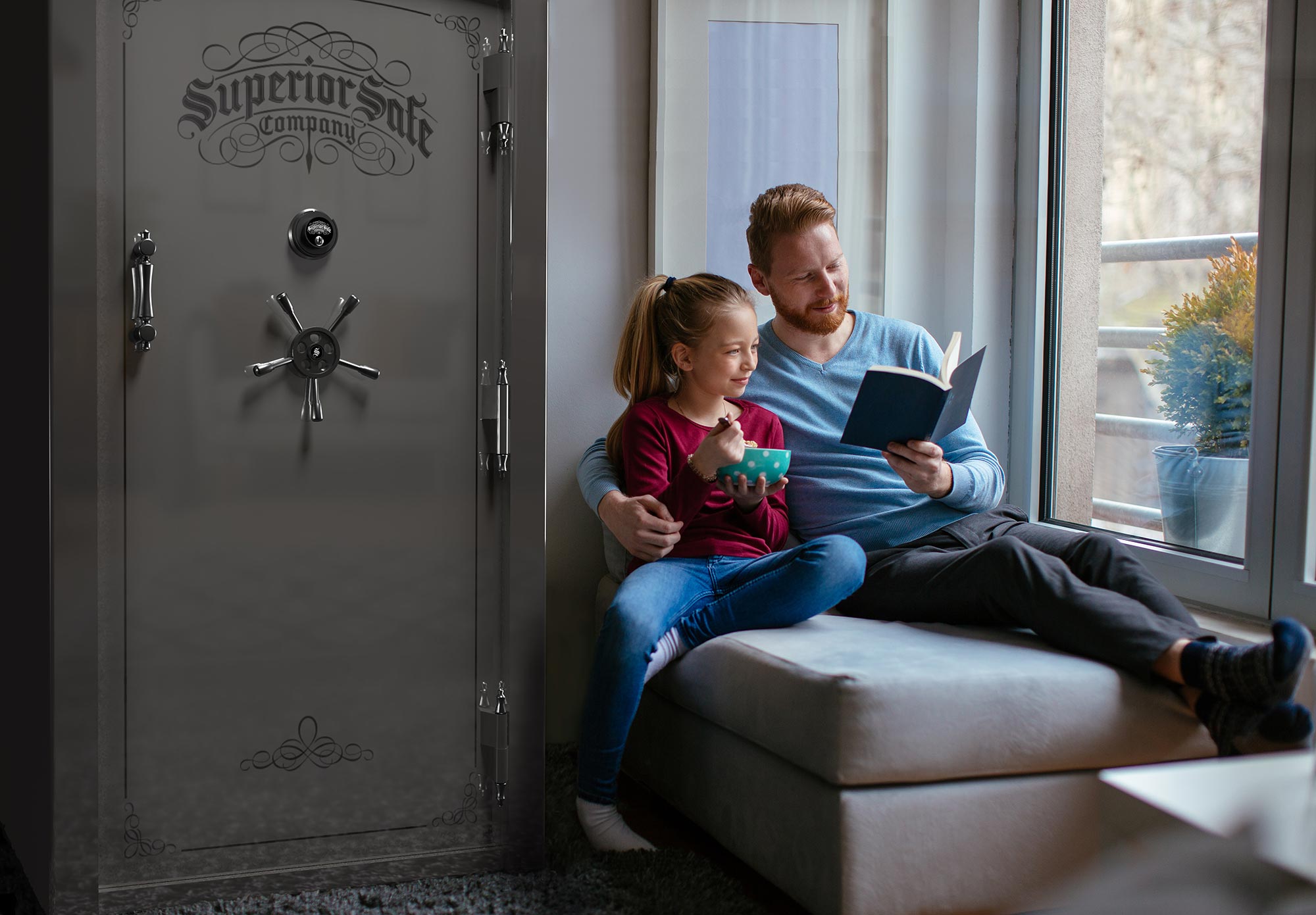
Gun Safe Terminology
Gun Safe Glossary
Buying a gun safe can be confusing. Don’t get befuddled by industry jargon. Become familiar with common gun safe terminology right here. Below, we have listed frequently used terms to assist you in becoming better prepared, more confident and less stressed when making your gun safe purchasing decisions.
- American-Made Steel
- ASME Certified Facility
- Anchors
- Anti-Pry Tabs
- B-Rate Safes
- Boltworks
- C-Rate Safes
- Cam Locking System
- Clutch Drive System
- Delta Force™ Door
- Dial Lock
- Diamond-Embedded Armor Plate™
- Door Organizer
- Double Steel Door Casement
- Electronic Locks
- Fire Rating
- Firewall (fireboard)
- Gauge
- Gypsum
- Hard Plate Lock Protection
- Hot Rod Dehumidifier
- Intumescent Seal
- Mechanical Dial Lock
- Pinion-Driven Radial Gear
- Re-Locker
- Safe Body
- Steel Gauge
- Steel Arch Doorway™
- TDR Safe
- Time Delay Lock
- TL-15 Rated Gun Safe
- TL-30 Rated Gun Safe
- Underwriters’ Laboratories (UL)
- UL Lock Rating
- U.L. Residential Security Container Rating (RSC)
- Unibody Construction
American-Made Steel: thick, durable steel that is made in America. It is used for premium safes, as opposed to Chinese steel, which is cheaper import steel that is less reliable and lacks in quality.
ASME Certified Facility: facilities that have been thoroughly inspected and approved for safety codes that are the standard when it comes to manufacturing. ASME is the American Society of Mechanical Engineers and is the leading organization in testing and certifying manufacturing equipment for safety.
Anchors: used to bolt safe to the floor to prevent movement of the safe for optimal protection against burglary.
Anti-Pry Tabs: installed on the bolt brackets on the inside of safe to increase pry resistance.
B-Rate Safes: safe rating that requires 1) safe doors are less than 1” thick and the steel walls are less than 1/2″ thick and 2) the safe has a locking device.
Boltworks: the mechanical parts of the locking bolts and gears on the interior of the safe.
C-Rate Safes: safe rating that requires 1) safe doors are at least 1” thick and the steel walls are at least 1/2″ thick and 2) the safe has a lock.
Cam Locking System: a typical lock used to secure doors; has a key hole on one end and a cam on the inside that rotates when key is turned to open the lock.
Clutch Drive System: a system designed to prevent internal damage from excessive pressure on handle.
Delta Force™ Door: a high quality safe door built with a thick steel bar around the door’s perimeter and fire insulation for maximum durability against forced entry and heat.
Dial Lock: a classic combination lock that is hooked on secured over a latch that requires turning the dial to a sequence of numbers to open the lock.
Diamond-Embedded Armor Plate™: a diamond that is bonded to steel plates on the interior of the safe to dull drill bits when drilling into safe is attempted.
Door Organizer: an organizer installed on wall interior of safe with compartments, which can be used to store knives, keys, and other important belongings.
Double Steel Door Casement: We add 2 layers of formed steel around the front of the safe to add strength and rigidity. This casement quadruples door strength, and increases pry resistance and hinge rigidity.
Electronic Locks: electronic safe lock that requires punching in correct code on keypad to open safe.
Fire Rating: a rating given to a safe that guarantees the belongings in safe will resist fire for a certain amount of time. The inside of the safe needs to stay below 350 degrees Fahrenheit in order to keep the integrity of documents. The levels of protection ratings range from 45 minutes to 2 hours of protection.
Firewall (fireboard): the lining inside a safe that prevents external fire from reaching contents by adding a layer of protection between the outside of the safe and the belongings inside. See Gypsum below.
Gauge: often referred to as the thickness of sheet metal.
Gypsum: is a mineral made of calcium sulfate, and it is the most commonly used firewall lining in premium gun safes.
Hard Plate Lock Protection: hard, steel plates placed inside the safe door to prevent drilling into safe.
Hot Rod Dehumidifier: a tool placed inside the safe to prevent any moisture build-up that may cause mildew and rust to form inside the safe.
Intumescent Seal: a “heat-expanding” seal that expands up to 10 times its original size in order to resist heat above 300 degrees Fahrenheit to protect belongings inside safe.
Mechanical Dial Lock: a combination lock on a safe that is opened by turning the dial to a sequence of numbers.
Pinion-Driven Radial Gear: superior gear system with 4-way active bolt works that is used for maximum protection against theft and forced entry.
Re-Locker: a protection device placed on the inside of the safe that with lock the bolt works when it is activated if drilling or heat is detected.
- Glass Relocker: tempered glass that is inserted into the safe and will trigger the bolt works to lock if broken by drill.
- Heat Relocker: a device that is inserted that will melt from any low heat used on the lock, preventing the bolt works from moving.
- Mechanical Relocker: a device placed on the back of the safe’s lock that will trigger the bolt works to lock when force is used on the safe’s lock.
- Remote Relocker: a device usually connected to the mechanical or glass relocker and is placed randomly to detect tampering of the safe’s door.
Safe Body: ours is pressure formed from one piece of steel, and then the top and bottom caps are welded on with 100% continuous MIG welds.
Steel Gauge: thickness of steel. Champion uses the thickest steel in the gun safe industry, and only uses American-made steel.
Steel Arch Doorway™: exclusive and premium steel door design created to provide maximum security and protection.
TDR Safe: a safe designed with torch and drill resistant (TDR) material.
Time Delay Lock: a safe lock that will only open after a set amount of time after code is entered to protect against burglary attempts.
TL-15 Rated Gun Safe: rating given to safes that have passed tests to attempt to open the safe for 15 minutes. Up to $200,000 in content value with burglar alarm and up to $100,000 without burglar alarm.
TL-30 Rated Gun Safe: rating given to safes that have passed tests to attempt to open the safe for 30 minutes. Up to $375,000 in content value with burglar alarm and up to $195,000 without burglar alarm.
Underwriters’ Laboratories (UL): a leading global safety company that sets the standards for testing safes for burglar resistance. They have been testing safes for burglar resistance for over 80 years.
UL Lock Rating: rating given by Underwriters’ Laboratories that defines how resistance a safe is to burglary, and is determined through tests where professionals attempt to break into safes with a variety of different tools.
U.L. Residential Security Container Rating (RSC): rating given by Underwriters’ Laboratories that is conducted by professionals who test the durability and resistance to burglary of the safe by attempting to break into the safe for 5 minutes with a variety of different tools.
Unibody Construction: a type of steel manufacturing where the safe door is built into the body of the safe rather than installed as a separate component to resist forced entry.
